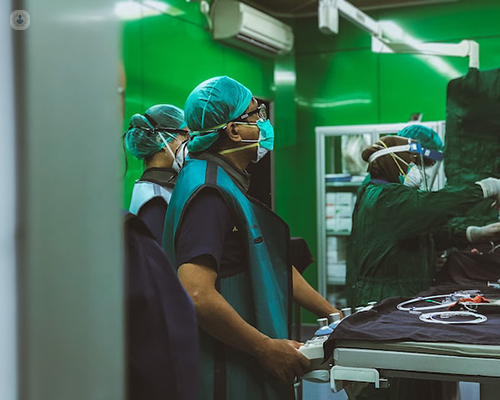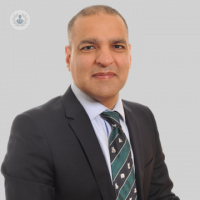Precision, accuracy and detail: Robotic surgery explained
Written by:Advances in medical technology have brought robotics to the forefront of modern-day surgery, increasing precision and accuracy in a variety of procedures. In this informative guide to robotic surgery, revered consultant general, laparoscopic and robotic hepatobiliary and pancreatic surgeon Mr Jawad Ahmad shares his expert insight on how robotic surgical procedures are performed and explains the advantages these techniques offer related to safety and patient outcomes.

What is robotic surgery?
Robotic surgery is essentially keyhole surgery performed with the help of a robot. It’s important to understand that the robot is not a surgeon – it does not operate on its own. It is just a surgical tool that the surgeon uses to operate on patients in a minimally-invasive way.
How does robotic surgery work?
The robot is an instrument with 3 key components – a tower screen, a surgical cart which has four arms and the surgeon’s console. The surgeon scrubs up for surgery and prepares the patient so the keyhole robotic instruments can be introduced – in my case, into the abdominal cavity. Some air is then used to inflate and make some space inside the abdomen and the robot can be safely docked.
The surgeon then descrubs and goes to their computer console, located only around one metre away from the patient, where they sit and operate the robotic instruments in order to complete the procedure. The use of these robotic assistance in keyhole surgery allows the surgeon to perform very precise, detailed and accurate dissection.
What are the applications of robotic surgery?
Initially, I thought that robotic assisted surgery would have very restricted applications but the extent to which this technology can be used has surprised us all. Particularly with the help of the new system that we have in our hospital, there’s no limit to what you can do robotically.
The bottom line is that if you are able to enter the abdomen safely, create space and have a keyhole view, you can essentially perform any type of surgery in the area. Initially, I introduced the use of robotic technology to my practice slowly but now I operate on all of my patients with robotic assistance rather than using open or laparoscopic techniques. With robotic assisted surgery, I’ve seen outstanding outcomes, good patient results and no significant complications.
What are the benefits of robotic surgery?
Robotic surgery has all of the benefits of keyhole (minimally invasive) operations. If we are performing a procedure on the pancreas or liver for example, minimally invasive techniques mean we don’t have to make big cuts on the abdomen and only a few tiny incisions are necessary - about five to eight millimetres each. We are able to introduce the necessary instruments into the abdomen to complete the surgery by first creating a port with a pen-sized piece of equipment. It is far easier to recover from those tiny half centimetre incisions than long cuts used in open surgery which can be between twenty and thirty centimetres in length.
In both the short and long term, patients do very well after minimally invasive surgery and can go home very quickly to enjoy a much shorter recovery. For these types of procedures, patients also don’t require epidural or very strong analgesia and there’s also no risk of longer-term complications including big, painful or unattractive scars or an incisional hernia. Although inside the abdomen the procedure is the same as in open surgery, the benefits of minimally invasive surgery ensure far better outcomes for patients.
Robotic surgery itself also has some advantages compared to standard keyhole surgery, including the range of movement possible with the instruments used. In standard laparoscopic (keyhole) surgery, the surgical tools used tend to be quite straight and don’t bend at the wrist, meaning the camera view provided is often compromised. On the other hand, the robot enables us to perform minimally invasive surgery in very complex cases as it uses EndoWrist instruments and gives a 3D and HD view of the abdomen. This helps us to work very precisely and take on cases which would otherwise be impossible to resolve with surgery.
Are there any additional risks associated with robotic surgery?
It’s an interesting question and sometimes people are quite concerned that the robot could be hacked or that it may operate on the patient independently. That is not possible as the robot is fully controlled by its operator, the surgeon, and it doesn’t make any movement on its own at all.
I have performed hundreds of operations robotically and I also teach robotic surgery and am in fact the only trainer in hepatobiliary surgery in the UK who is qualified to teach on robotics in surgery. So far, there hasn’t been a single incident of injury or bad outcomes caused by robots in surgery. It is a very safe instrument and gives excellent outcomes when used to operate on the patient.
If you would like to schedule a consultation with Mr Ahmad, you can do so by visiting his Top Doctors profile.



